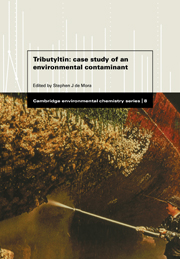Book contents
- Frontmatter
- Contents
- Contributors
- Preface
- 1 The tributyltin debate: ocean transportation versus seafood harvesting
- 2 Industrial manufacture and applications of tributyltin compounds
- 3 The analysis of butylated tin compounds in the environment and in biological materials
- 4 The occurrence, fate and toxicity of tributyltin and its degradation products in fresh water environments
- 5 The distribution and fate of tributyltin in the marine environment
- 6 Biological effects of tributyltin on marine organisms
- 7 TBT-induced imposex in neogastropod snails: masculinization to mass extinction
- 8 Environmental law and tributyltin in the environment
- 9 The efficacy of legislation in controlling tributyltin in the marine environment
- Index
1 - The tributyltin debate: ocean transportation versus seafood harvesting
Published online by Cambridge University Press: 04 August 2010
- Frontmatter
- Contents
- Contributors
- Preface
- 1 The tributyltin debate: ocean transportation versus seafood harvesting
- 2 Industrial manufacture and applications of tributyltin compounds
- 3 The analysis of butylated tin compounds in the environment and in biological materials
- 4 The occurrence, fate and toxicity of tributyltin and its degradation products in fresh water environments
- 5 The distribution and fate of tributyltin in the marine environment
- 6 Biological effects of tributyltin on marine organisms
- 7 TBT-induced imposex in neogastropod snails: masculinization to mass extinction
- 8 Environmental law and tributyltin in the environment
- 9 The efficacy of legislation in controlling tributyltin in the marine environment
- Index
Summary
Introduction
Tributyltin is not a compound in its own right, but only a constituent part of molecules in this class of organotin substances. It comprises three n-butyl chains attached to a single tin atom via covalent Sn–C bonds. As the tin exists in the form Sn(IV), the moiety displays an univalent positive charge. Commercial products are typically available in the form of bis(tributyltin) oxide (known as TBTO), acetate (TBT–OAc), halides (TBTF, TBTCI) and as the co-polymer with methylmethacrylate (TBTM). Industrial applications of TBT compounds followed the recognition of its biocidal properties, first noted in the early 1950s (Bennett, 1983). Although present applications include molluscicides, stone preservation, and disinfectants, the most important usage remains in wood preservatives and anti-fouling paints (Blunden & Evans, 1990). The production and use of TBT compounds in these two contexts are reviewed here in Chapter 2. Several other organotin compounds are routinely utilised in agricultural biocides, catalysts and as heat and light stabilisers for PVC. Reviews of environmental behaviour of such substances can be found elsewhere (Blunden, Hobbs & Smith, 1984; Maguire, 1991).
Because TBT can act as a broad spectrum biocide, it is useful in the preservation of wood, which is subject to decomposition via bacteria, fungi and insects. Unprotected soft woods degrade relatively quickly giving useful lifetimes of only one to two years. TBT treatment can extend this time to decades. TBT formulations have also proved useful for the preservation of marine timbers (Hill & Killmeyer, 1988).
- Type
- Chapter
- Information
- TributyltinCase Study of an Environmental Contaminant, pp. 1 - 20Publisher: Cambridge University PressPrint publication year: 1996
- 10
- Cited by



